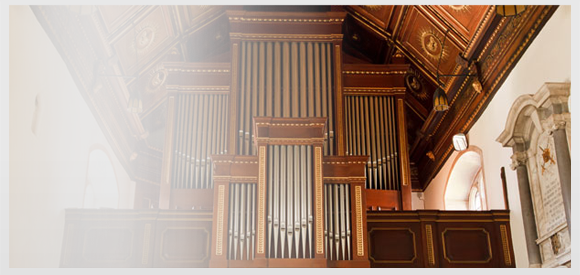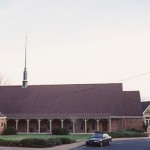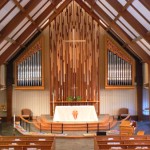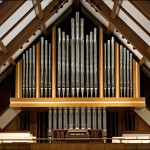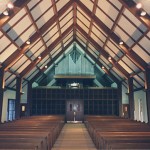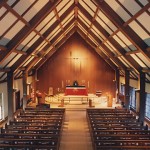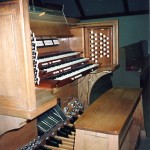Good Shepherd Episcopal, Lookout Mtn
The first pipe organ for the church was Moller opus 8558, a two-manual ofthe Artiste unit organ
series, with three ranks. The organ was moved to St.Thaddaeus Episcopal Church in Chattanooga
in 1962 when Good Shepherd saw theinstallation of its 3-manual 34-rank Hillgreen, Lane. The organ
was one of the very last that Hillgreen, Lane built.
At Easter 2008, Good Shepherd completed a two phase organ project with the completion of
Parkey Organbuilders Opus 8 and 9. Opus 9 was actually completed first, and is a 12 rank antiphonal
organ in two chambers on either side of the altar facing down the long axis of the nave. A new 2 manual
and pedal fully portable console was provided to control this instrument only, which can be used as an
independent instrument for smaller services or choral/concert work at the front of the nave. This organ
also serves as the Chancel division of the main instrument at which time the hooded Festival Trumpet is
made available.
Opus 8 is the main instrument of 37 ranks over three manuals and pedal and is located in the rear
gallery. The instrument retained 17 ranks of the 1961 Hillgreen and Lane organ which was installed
when the building was completed. Opus 8 is designed on the American Classic model, with generous
scaling for the Principal choruses and reeds of varying character and construction. The 8’Hautbois is
English in quality and the 8’Cromhorne is very bold and colorful. The instrument contains four 8’ principals
on the Great, Chancel, Pedal and Choir divisions; three more than the previous instrument. Flute colors
were also greatly increased with each flute’s construction and material as well as voicing being appropriately
varied. The Swell and Choir divisions are chambered and under expression, while the Great and Pedal
occupy cantilevered, slider chests of Parkey Organbuilders design.
There were particular design goals which the congregation desired to meet in the completion of this instrument.
First, was an increased presence of the instrument in the room to lead hymn singing and second was the ability
to use the organ with performing groups and services in the front of the nave. Both of these goals were met.
Thirdly, to complete a console with minimal size to allow for additional space in the balcony and for good
sight lines. Nearly two feet of depth and several inches of height were saved over the previous console
without creating a crowded or diminished look and feel. Over the last decade, several changes to other
parts of the nave have increased its viability for music, namely the elimination of sound absorbent surfaces.
A slate floor was installed, window draperies were removed and sound absorbent panels on the wall were
removed and replaced. A new acoustically transparent balcony railing is currently in the design stages.
Parkey OrganBuilders, Op. 8 and 9, 2008, 3/49
Hillgreen, Lane & Company, Op. 1240, 1962, 3/34
GREAT
8′ Spitzprinzipal
8′ Nachthorn
8′ Bourdon SW
4′ Prinzipal
4′ Flute SW
2 2/3′ Quinte
2′ Prinzipal
III-IV Mixture
16′ Double Trumpet SW
Tremulant
Sub
Unison Off
Super
Chimes
SWELL
16′ Bourdon
8′ Claribel Flute
8′ Viola
8′ Viola Celeste
4′ Principal
4′ Flute 24
2 2/3′ Nazard
2′ Piccolo 12
III Mixture
8′ Trumpet
4′ Clarion 12
Tremulant
Sub
Unison Off
Super
5 blank knobs
CHOIR
8′ Flute a Fuseau
8′ Dulciana
8′ Unda Maris
4′ Flute Ouverte
2 2/3′ Nazard
2′ Doublette
1 3/5′ Tierce
8′ Bombarde
8′ Cromorne
Tremulant
Sub
Unison Off
Super
3 blank knobs
PEDAL
32′ Resultant Principal 1
32′ Resultant Bourdon 3
16′ Major Bass
16′ Spitzprinzipal 12
16′ Contra Viola 12
16′ Bourdon SW
8′ Montre
8′ Viola SW
8′ Bourdon SW
4′ Cor de Nuit
III Fourniture
16′ Double Trumpet 12
8′ Trumpet
Unison Off
Super
Chimes Gt
Blank
